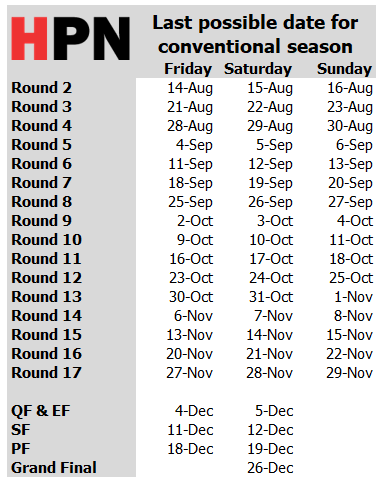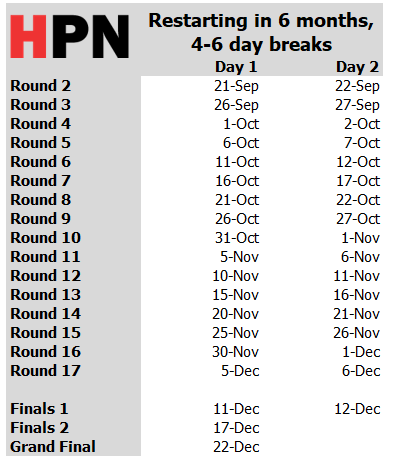The inevitable coronavirus-driven shutdown of the AFL has come perhaps a couple of weeks sooner than the league would have expected or hoped. National and international events have dictated that a national sporting competition is now impossible, due to lockdowns and interstate travel bans in parts of the country.
We have been warned by the Prime Minister and Australian Chief Medical Officer that restrictions may last up to 6 months, meaning that it also may be many months before restrictions ramp down enough that any AFL games are possible again. The question then becomes at what point must the AFL season be fully abandoned, assuming Gillon McLachlan’s stated intention to finish by the end of the year is a hard limit.
HPN has run the numbers to identify the cutoff dates for particular kinds of fixture.
1: A season without compromise
First, as a benchmark, here’s what the latest possible “conventional” season would look like.
By conventional, HPN means a season where rounds run from Friday to Sunday, perhaps with odd Thursday or Monday fixtures around the September and October public holidays in relevant states. If such a season restarted on Friday August 14, it could have a Saturday grand final on Boxing Day.
The most likely scenario for a return may be a single site solution, which should ensure that any risk to players and essential staff is minimised. As the AFL owns Docklands, they may be able to arrange the season in and around that district in Melbourne. Otherwise, a city such as Perth or a more remote location may be willing to step up.
If a more standard, multi-city solution is sought, such a season is likely to be unable to use the major cricket grounds for the latter part of the year. This is due to the traditional summer arrangements with cricket takeover of grounds and specifically and the men’s T20 World Cup. If that event is cancelled, the AFL may get lucky, but if not, footy will still have decent options outside of the biggest grounds. The availability is likely as follows:
- Queensland: Carrara Stadium (25,000)
- New South Wales: Sydney Showground (24,000)
- Victoria: Docklands Stadium (53,500)
- South Australia: Norwood Oval (22,000), Alberton Oval (15,000)
- Western Australia: Fremantle Oval (17,500), Lathlain Oval (15,000)
There would be several similarly sized options in Adelaide and Perth, but it’s a fair assumption that this is where the clubs and league would probably choose to play if given the chance to return to each city.
2. Restart in six months, shorten the time between rounds
If August 14 passes by without footy, real sacrifices will start needing to be made. The first item to go might be the current structure of playing football exclusively on weekends.
The next step is to start reducing break times. This has been foreshadowed as likely by the AFL in measures established and mooted, such as reducing playing times and suggestions of expanding lists with a mini-draft from the non-operating state leagues. Here’s how it looks if we restart the season on September 21, six months from today, sticking with the two day rounds starting every five days:
A two-day round starting every five days from late September, with a truncated three round finals series, will finish around Christmas. Of course, this could be brought forward to any time between the August 14 date and when it is actually safe to play. A contracted finals series might also be considering – potentially using the conventional Final Six system, or an eight team single elimination bracket.
While this solution has potential, it is possibly the most unlikely option on the table due to the lack of true compromise, lack of tradition, and loss of weekend footy at points during the season cycle.
3. A “roundless” season
If we start to push into October, both the concept of “rounds” and the luxury of regular full length breaks must come into consideration. Competitions like the Big Bash, NHL and the NBA, which like to have games on every night, offer models here. The AFL has indeed flagged this with McLachlan now referring to a “153-game” season rather than a 17-round one.
To take one of the most crunched versions of the fixture, teams playing an average of 3 games every ten days, i.e. 3.33 average days between games, would let a season start in mid October and rip through 16 games in less than two months. Here’s what some example team fixtures might look under such a scenario, with an average of four days between games:
At this point, fatigue mitigation measures such as substantially larger lists become utterly vital, as most players are going to require rest at some point due with such a demanding schedule. Care would need to be taken in player management. Games may need to be reduced in length further, more in accordance with “lightning carnival” norms.
From a club point of view, planning and analytics would also be vital for such a major alteration, because managing selection strategies to maintain competitiveness would be a key task.
It should be noted that such a “roundless” approach does not need to only be considered for an ultra-condensed mid-October start. It might also be commercially preferable to the AFL over a rigid two-day round option presented above because once we start ignoring the traditional weekend rounds, a continuous stretch of games could ensure weekend primetime slots still be filled.
For example, here’s a set of matches that start in early September like option 2, with a spread of games averaging around a gap of 5.6 days. It results in roughly 6 games per month, leading to three weeks of finals and then a Boxing Day Saturday grand final.
Footy isn’t done
Assuming projections of a six month period with some form of lockdown is not an under-estimate, it should be clear that with some creativity and the use of grounds not needed for cricket, the AFL stands a reasonable chance of getting through the remaining 16 rounds of the truncated 17 round season.
HPN has been informed that clubs and club officials at some clubs are optimistic that there will be some further footy this year – hence the reason for a suspension and not a cancellation. Few know exactly how this virus will develop in Australia and across the world, and variables such as cross-border movement are also an unknown. Keeping all options as open as possible is the most prudent course of action right now.
The AFL would be hoping to begin again by early August, at least behind closed doors, but could plausibly start any time up to mid October and get a season done, in order to salvage some of that vital lifeblood of broadcast money.






It is also possible to play a shorter regular season than 17 games.